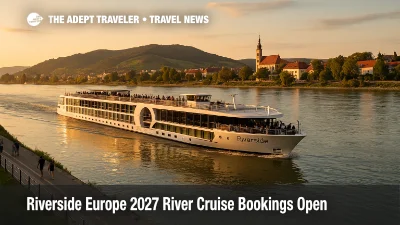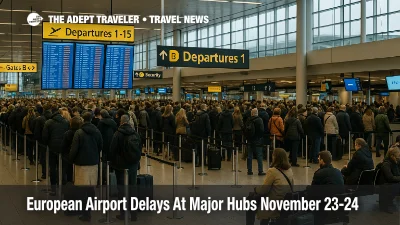Wachau Valley, Austria
Tucked between the rolling hills of Lower Austria, the enchanting Wachau Valley unfurls along the banks of the majestic Danube River, offering a timeless escape for those who travel to Wachau Valley, Austria. This UNESCO World Heritage Site dazzles with terraced vineyards that seemingly weave golden threads across the landscape, beckoning travelers to savor the crisp, white wines for which the region is famous. As you travel to Wachau Valley, your senses are immersed in the bouquet of apricots ripening in the sun, their delicate sweetness echoing the rich fruit-laden air. Picture strolling through quaint villages where time stands still—earthen paths leading to the echo of history in Gothic churches and ancient castles that loom, steeped in legend. The gentle breeze whispers through lush orchards while the vibrant colors of Fall foliage paint a breathtaking backdrop, urging you to pause and soak in the stillness and beauty. The Wachau Valley, Austria, is more than just a destination; it's a call to reconnect with nature and history in a symphony of sight, sound, and taste that lures every traveler deeper into its dreamlike embrace.
Wachau Valley, Austria Travel Season
Travel to Wachau Valley, Austria, offers a myriad of experiences throughout the year, but understanding the best seasons can greatly enhance your visit. Wachau Valley is renowned for its breathtaking landscapes, historical sites, and charming villages, making it an alluring destination for travelers year-round. However, if you're seeking ideal conditions, specific seasons shine brighter than others.
The peak season for travelers visiting Wachau Valley, Austria, typically falls in the spring and early fall months. From April to June and September to October, the valley is draped in vibrant colors and mild weather, making these months particularly favorable for exploration. During the spring, the blossoming apricot trees create a picturesque backdrop against the lush vineyards. Fall, on the other hand, offers the magic of harvest time, with vineyards bustling with activity and wine festivals becoming a significant highlight for visitors.
Visiting During Off-Peak Times
For those looking to escape the crowds, traveling to Wachau Valley in the off-peak season is an excellent choice. Late autumn, particularly in November, sees fewer tourists, providing a more serene experience amidst the stunning landscape. Although the weather can be cooler, it's a small price to pay for the tranquility you'll find while exploring villages like Dürnstein and Krems. Winter months bring a dusting of snow, creating a fairy-tale setting, especially around Christmas when local markets add a festive charm to the region.
Events and Local Celebrations
When planning a travel to Wachau Valley, Austria, timing your visit with local events enhances the cultural experience. In spring, the Wachau Marathon attracts runners and sports enthusiasts who revel in the beautiful route along the Danube River. Autumn is synonymous with the grape harvest, where local vineyards open their doors for tastings and the opportunity to witness winemaking in action. The Wachau Valley wine festival, held in various vineyards, is particularly popular, offering a taste of the region's acclaimed wines.
Summer Delights and Winter Charms
Summer in Wachau Valley is marked by warm temperatures ideal for cycling or enjoying a leisurely cruise on the Danube. The landscapes come alive with vibrant greenery, and while this period draws tourists owing to school vacations, the charm of the valley is undeniable. Conversely, winter may not be the first choice for many travelers to Wachau Valley, Austria, but it offers unique advantages. The absence of crowds allows for more personal experiences at historical sites, and the cold, crisp air sets a unique scene for acknowledging the area's rich history and architectural beauty.
Each season in Wachau Valley holds its own allure, providing diverse experiences for every type of traveler. Whether you're enticed by the bustling energy of peak season or the quiet allure of the off-peak months, traveling to Wachau Valley, Austria, promises unforgettable memories beautifully intertwined with this region's natural and cultural splendors.
The Weather and Seasons in Wachau Valley, Austria
The picturesque Wachau Valley, Austria, situated along the Danube River, is renowned for its stunning landscapes and charming villages. Travelers venturing to Wachau Valley can expect a unique mix of temperate conditions that showcase the beauty of this region year-round.
Spring in Wachau Valley
As the snow begins to melt, spring in Wachau Valley signals the arrival of warmer temperatures, ranging from 50°F to 68°F (10°C to 20°C). This season is ideal for those planning a travel to Wachau Valley, as it offers a lively backdrop of blossoming apricot trees and verdant vineyards. Rainfall during spring is moderate, so travelers should pack an umbrella, but sunny days prevail more often than not. The gentle climate makes it the perfect time to explore outdoor activities and attend local events like the famous Wachau Marathon.
Summer Adventures in Wachau Valley, Austria
Summer in Wachau Valley is a delightful time to visit, with temperatures averaging between 68°F and 86°F (20°C and 30°C). The warm weather invites travelers to enjoy a variety of outdoor experiences, such as hiking, cycling, and river cruises. While rainfall is relatively low during these months, the occasional thunderstorm can occur. Humidity levels rise slightly but remain comfortable, ensuring an enjoyable travel experience to Wachau Valley without any oppressive heat.
Autumn's Splendor in Wachau Valley
Fall transforms Wachau Valley into a tapestry of rich golden and amber hues, offering a fantastic setting for travelers exploring this Austrian gem. Temperatures during autumn fluctuate from 41°F to 68°F (5°C to 20°C), providing crisp and refreshing weather conditions. This season is particularly significant for wine enthusiasts, as the grape harvest occurs in September, leading to numerous wine-tasting events and festivities. The conditions are perfect for leisurely strolls through the vineyards and quaint towns.
Winter in Wachau Valley, Austria
During winter, Wachau Valley experiences a colder climate, with temperatures dropping to between 28°F and 41°F (-2°C to 5°C). While snow is not as abundant as in other Austrian regions, frosty mornings and occasional snowfall add a serene beauty to the landscape. Travelers visiting Wachau Valley in winter can partake in seasonal events such as Christmas markets and enjoy the tranquil atmosphere, which contrasts beautifully with the busier tourist seasons.
The best time to travel to Wachau Valley depends on personal preferences, but many find the spring and autumn to offer the most favorable conditions. These seasons provide mild weather perfect for outdoor exploration and abundant cultural experiences, making any travel to Wachau Valley a memorable one.
Accepted Payment Methods and Other Payment Information in Wachau Valley, Austria
Travel to Wachau Valley offers a delightful mix of natural beauty and cultural experiences, and understanding the payment options available can enhance your visit. In Wachau Valley, Austria, the local currency is the Euro (EUR), and it is widely accepted across various establishments including shops, restaurants, and hotels. When traveling to Wachau Valley, you will find that credit cards, particularly Visa and Mastercard, are accepted in most places. However, it's wise to carry some cash, especially when visiting more rural areas or smaller establishments that may not accept cards.
Credit card usage in Wachau Valley is generally straightforward, but there are some nuances. American Express is accepted in fewer locations compared to Visa and Mastercard, so if you prefer using an Amex card, it’s best to confirm with the establishment beforehand. Discover card users may face more challenges, as this card is not widely accepted. If you plan to rely heavily on credit cards for your travel needs, checking card acceptance in advance is a prudent step.
Cash remains a critical component for travelers in Wachau Valley, Austria, as many smaller vendors, markets, and local attractions may only accept cash. ATMs are readily available in towns and cities, allowing for convenient withdrawal of Euros. When indulging in local cuisine or enjoying services, tipping is customary but not mandatory; rounding up the bill or leaving a modest tip of about 5-10% is appreciated. In more formal dining situations, a slightly higher tip might be expected, mirroring practices common in many other parts of Europe.
During your travel to Wachau Valley, always consider carrying a mix of both coins and notes. The scenic Wachau Valley is peppered with opportunities to participate in wine tasting tours, bike renting, or boat trips along the Danube. While many of these attractions have adapted to card payments, having cash on hand ensures you won't miss out on any experiences due to payment method limitations. As you explore the Wachau Valley, Austria’s postcard-perfect landscapes and rich heritage, being prepared with appropriate payment methods will ensure your travel adventure is seamless and memorable.
Why You Should Travel to Wachau Valley, Austria
Travel enthusiasts looking to discover one of Europe's hidden gems should consider a journey to Wachau Valley, Austria. This stunning region offers a multitude of exciting attractions and experiences that cater to a wide variety of interests. The rich tapestry of culture, history, and unparalleled natural beauty makes travel to Wachau Valley an unforgettable experience.
Vineyards and World-Class Wine
At the heart of Wachau Valley lies its reputation as one of the premier wine regions of Austria. Travelers visiting Wachau Valley can indulge in guided tours of picturesque vineyards, sampling distinguished local wines like Grüner Veltliner and Riesling. The unique taste of Wachau’s wines comes from the valley's perfect terroir, with steep slopes that overlook the Danube River, making any wine lover's travel to Wachau Valley a true delight.
Charming Medieval Towns
Exploring the quaint medieval towns scattered across Wachau Valley transports travelers back in time. Towns such as Dürnstein, Spitz, and Melk enchant visitors with their cobbled streets, centuries-old architecture, and charming ambiance. Each town holds a distinct charm that makes travel to Wachau Valley, Austria, an enriching journey through history.
The Majestic Melk Abbey
The Melk Abbey is a masterpiece of Baroque architecture that dominates the skyline of Wachau Valley. This impressive structure, with its opulent frescoes and praiseworthy library, offers travelers a glimpse into the monastic life of centuries past. A visit to this UNESCO World Heritage site is a highlight for anyone traveling to Wachau Valley.
Cruising Along the Danube River
One of the most serene ways to experience the natural beauty of Wachau Valley, Austria, is through a cruise along the Danube River. Travelers can soak in the scenic landscapes, dotted with terraced vineyards and historic castles, while gently gliding down one of Europe's great waterways. This leisurely travel experience provides a unique perspective of Wachau Valley’s breathtaking sights.
Historical Castles and Ruins
Wachau Valley is peppered with ancient castles and intriguing ruins that beckon history buffs and adventurers alike. The story-rich Aggstein and Dürnstein castles are just a couple of the impressive structures travelers can explore, each offering panoramic views and centuries-old legends. Such sites are quintessential stops when exploring Wachau Valley.
Exquisite Culinary Experiences
Travel to Wachau Valley, Austria, is not complete without indulging in its delicious culinary offerings. Fresh, locally-sourced ingredients play a starring role in the region’s cuisine, with dishes such as apricot dumplings and smoked fish delighting the palate. Pair the local fare with Wachau's celebrated wines for a truly sumptuous dining experience.
Breathtaking Hiking Trails
Nature enthusiasts traveling to Wachau Valley will find a paradise of hiking trails that meander through vineyards, forests, and along the banks of the Danube. Routes like the Wachau World Heritage Trail offer hikers spectacular views and the chance to encounter local wildlife. The natural splendor of these paths provides travelers the opportunity to connect deeply with the landscape of Wachau Valley, Austria.
Rich Cultural Festivals
The vibrancy of Wachau Valley’s cultural scene is celebrated through numerous festivals held throughout the year. Events like the Wachau Gourmet Festival and apricot blossom celebrations showcase the region’s rich traditions and offer travelers an immersive cultural experience. Participating in these festivities is a memorable way to enjoy a deeper understanding of Wachau Valley's heritage.
Luxury and Boutique Accommodations
Wachau Valley, Austria, offers a delightful range of accommodations from luxurious hotels to charming boutique inns. Many places provide stunning views, excellent service, and easy access to the valley's attractions, making travel to Wachau Valley both comfortable and indulgent. A stay in such accommodations enhances the overall travel experience, adding a touch of luxury to the journey.
Artisan Craftsmanship and Shopping
Travelers interested in artisan craftsmanship will find an array of delightful boutiques and shops throughout Wachau Valley. Local craftsmen create unique items ranging from handcrafted jewelry to traditional Austrian clothing. These treasures make for exquisite souvenirs and gifts, serving as lasting memories of any trip to Wachau Valley.
For anyone seeking a travel adventure that combines history, culture, natural beauty, and world-class wine and cuisine, photography-worthy landscapes, and rich cultural experiences make travel to Wachau Valley, Austria, a remarkable choice.
The History of Wachau Valley, Austria
Rich with history and brimming with cultural significance, the Wachau Valley offers a spectacular journey through time, making it a prime destination for history enthusiasts looking to travel to an extraordinary place. Located in the lower Austrian region along the Danube River, this picturesque valley boasts a history that spans over a millennium. The Wachau Valley has been recognized for its outstanding cultural landscape, punctuated by well-preserved medieval architecture and scenic vineyards, which have contributed to its designation as a UNESCO World Heritage Site. The region's history is profoundly marked by its strategic position along the Danube, which facilitated trade and cultural exchange during ancient and medieval times. This confluence of historical events and geographical advantages has shaped the Wachau Valley into a locale steeped in cultural riches and historical narratives.
Throughout its storied past, the Wachau Valley has witnessed numerous key historical events that have significantly impacted its development. One of the valley's most notable historical landmarks is the Melk Abbey, a stunning Baroque edifice perched on a rocky outcrop above the town of Melk. Founded in the 11th century, it has been an important center of spiritual and cultural life in the region. The abbey's extensive library and ornate architectural design are a testament to the valley's rich monastic history and the influence of the Benedictine order in Austria. Additionally, the imposing ruins of Dürnstein Castle hold a legendary narrative, famously associated with King Richard the Lionheart, who was imprisoned there in the late 12th century. These storied sites make the Wachau Valley a compelling destination for those eager to delve into the medieval history of Europe.
Cultural heritage is another compelling reason to travel to Wachau Valley, showcasing a side of Austria deeply rooted in traditions that have been carefully preserved and passed down through generations. The region is renowned for its viticultural heritage, with vineyards that produce some of the world’s finest white wines, especially the celebrated Grüner Veltliner and Riesling varieties. The Wachau Valley's commitment to preserving its winemaking traditions speaks volumes about its cultural identity, with numerous local festivals and events celebrating the annual wine harvest. Travelers can enjoy the convivial atmosphere of these events, embracing both the historical and cultural dimensions of the valley through its revered wine culture. The symbiosis of natural beauty and historical depth ensures that a visit to the Wachau Valley is not just a travel experience but an cultural immersion.
For history lovers pondering travel to Wachau Valley, Austria, the experience promises more than just explorations of age-old sites. The valley's history is intricately woven into the tapestry of its vibrant present, visible in the charming towns that dot the landscape. Krems and Spitz are such towns where Renaissance and Gothic architecture seamlessly blend with the valley's scenic beauty. Each town offers a unique glimpse into the region's past as travelers wander through cobblestone streets lined with ancient buildings, absorbing the essence of an enduring cultural legacy. From ancient folklore to historical monuments, every corner of Wachau Valley holds stories waiting to be uncovered by the discerning traveler. Whether through storytelling, architecture, or the aromatic scents of a freshly poured glass of wine, the Wachau Valley embraces all who travel to its storied landscape, offering a journey that enriches the soul and ignites the curiosity of every visitor.
The Culture of Wachau Valley, Austria
Wachau Valley, Austria is a dazzling stretch of land bordered by the Danube River, renowned not just for its picturesque landscapes and vineyards, but for its vibrant cultural life as well. This region is steeped in a strong tradition of winemaking, and the festivals surrounding this craft are a significant part of local life. Every autumn, the valley comes alive during the annual wine harvest festivals, celebrated with gusto and drawing visitors from far and wide. These festivals are a sensory feast, offering travelers the chance to savor local delicacies and wines, while enjoying traditional music and dance performances that are an intrinsic part of Wachau Valley's cultural fabric.
The people of Wachau Valley are deeply passionate about preserving their heritage, which is evident in their daily customs and lifestyle. They maintain a strong connection to their roots, which is reflected in their warm hospitality and community-driven lifestyle. Villages in the Wachau Valley often organize gatherings and events throughout the year that put local traditions and crafts on display. Travelers to Wachau Valley, Austria can immerse themselves in these events, experiencing firsthand the region's legacy of craftsmanship, from cobblestone artisans to local folk artists, offering a glimpse into a world much different from the rapid pace of modernity.
Music and performance art often take center stage in Wachau Valley's cultural expressions. The valley's churches and historic venues regularly host classical concerts and performances, drawing on the region’s deep musical roots. Traditional Austrian folk music, with its melodic harmonies and rustic charm, is another staple of the cultural tapestry. Visitors who travel to Wachau Valley have the opportunity to attend intimate performances where they can experience this captivating music firsthand, potentially accompanied by regional dances that have been passed down through generations. These cultural performances are not only entertaining but serve as a vital link to the region’s past, celebrated and cherished by locals and tourists alike.
Wachau Valley also boasts a unique blend of cultural influences, partly due to its location as a historical crossroads in Europe. Over the centuries, various cultural tides have left their mark on the region, contributing to its present-day diversity. While the native Austrian culture prevails, elements of neighboring cultures subtly merge, creating a diverse cultural experience for any traveler. Efforts to preserve this rich heritage are evident in the numerous museums and cultural sites dedicated to documenting and sharing both the historic and contemporary cultural narratives of the valley. Such endeavors ensure that while Wachau Valley moves towards the future, its colorful cultural tapestry continues to thrive, making it a must-visit destination for those looking to explore the depths of Austrian tradition and life.
The Culinary Experience of Wachau Valley, Austria
Travel enthusiasts exploring culinary delights will find Wachau Valley, Austria, a gem of sensory indulgence. When you travel to Wachau Valley, you are not only visiting a picturesque region; you're uncovering a sumptuous tapestry of flavors that reflect the area's rich heritage and cultural traditions. Anchored along the Danube River, this area boasts an abundance of local produce, which forms the backbone of its cuisine. Traditional eateries and family-run establishments proudly serve up specialties that highlight the natural bounty of the region, including fresh vegetables, river fish, and handcrafted cheeses. As you travel through Wachau Valley, expect to relish the distinctive flavors of apricot-based specialties, such as Marillenknödel, a sweet dumpling filled with ripe apricots and a hint of sugar, which encapsulate the valley’s love affair with this fruit.
Must-try dishes when you travel to Wachau Valley include Wachauer Laberl, a type of hearty sourdough bread often enjoyed with a sampling of local cheeses and meats. This bread is a mainstay at most meals and perfectly complements the valley's slow-cooked meats and aromatic soups. For those interested in seafood, the locally caught fish dishes, often prepared with delicate herbs and served alongside seasonal vegetables, offer a taste of the Danube's bounty. Another noteworthy treat is the Wachauer Weintrauben, a delicacy involving grapes steeped in tradition and innovation, which is a favorite among locals and tourists alike.
Beverages are an essential part of the Wachau Valley experience. The region is renowned for its world-class wines, particularly the crisp Grüner Veltliner and the aromatic Riesling, which benefit from the unique climatic conditions and the mineral-rich soil of the valley. Wine tasting tours are a popular way to experience Wachau Valley, Austria, where travelers can savor these exquisite wines while learning about the meticulous viticulture behind each bottle. For those interested in spirits, the apricot schnapps, locally known as Marillenschnaps, is a testament to the valley’s expertise in crafting the perfect blend of flavors that are both potent and well-balanced.
Diversity in dining experiences is present throughout Wachau Valley. Alongside fine dining establishments that offer a fusion of traditional and contemporary Austrian cuisine, travelers can enjoy lively food markets teeming with fresh produce and homemade delicacies. Seasonal food festivals, such as the famed apricot festival, celebrate the region's produce, offering visitors fantastic opportunities to engage with local culture. These events often feature a variety of culinary options to cater to different dietary preferences, including vegan and vegetarian fare, ensuring that everyone who travels here can indulge in the vibrant flavors Wachau Valley has to offer.
What to See and Do in Wachau Valley, Austria
As you plan your travel to Wachau Valley, Austria, prepare to be entranced by one of the most picturesque regions in Europe. Each twist and turn of the river brings unique and beautiful vistas that have inspired artists and travelers for centuries.
Melk Abbey: A Historical Marvel
Perched high on a rocky outcrop overlooking the Danube River, Melk Abbey is a must-see for every traveler to Wachau Valley, Austria. This Baroque masterpiece displays architectural grandeur with its elaborate rooms and extensive library housing countless medieval manuscripts. Families and solo travelers alike will find wandering through the abbey’s ornate halls and tranquil gardens an enchanting experience that offers a glimpse into the region's rich history.
Danube Biking Trail: Nature Meets Adventure
Adventure seekers traveling to Wachau Valley will savor the thrill of biking along the scenic Danube cycling trail. This route winds through vineyards, forests, and charming villages, offering cyclists stunning views at every corner. Rent a bike from the several local outlets and immerse yourself in the natural beauty and serene atmosphere that define the Wachau Valley.
Dürnstein Castle: A Ruined Fortress with a View
Overlooking the quaint village of Dürnstein, the ruins of Dürnstein Castle offer a rewarding hike and breathtaking panoramas of the Wachau Valley. The hike to the castle is perfect for families seeking an outdoor adventure with a dose of history; legend has it that Richard the Lionheart was once imprisoned here. The effort is worth the stunning views of the valley and river below, making it a top spot for photography enthusiasts.
Wachau Wine Experience: A Taste of Tradition
No travel to Wachau Valley is complete without sampling its world-renowned wines. The region is famous for its distinctive Grüner Veltliner and Riesling wines. Embark on a wine-tasting journey through cozy, family-run wineries where each sip tells the story of its terroir. Whether you're an oenophile or simply appreciate a good drink, these wine experiences will deepen your connection to the valley's culture and landscape.
Spitz: The Heart of Wachau
The charming village of Spitz is nestled amidst verdant vineyards and is a delightful stop for those traveling to Wachau Valley, Austria. Its picturesque Gothic church and traditional wine taverns, known as Heurigen, invite travelers to slow down and savor the region's local cuisine. Spitz provides a perfect opportunity for solo travelers to mingle with locals and enjoy the laid-back lifestyle that characterizes the valley.
Gottweig Abbey: A Spiritual Retreat
Set atop a hill, Gottweig Abbey offers a spiritual retreat and a moment of reflection amidst your travels through Wachau Valley. This Benedictine monastery boasts stunning frescoes and a museum showcasing ecclesiastical artifacts. Families can enjoy panoramic views of the surroundings from the abbey's terrace, which add to the peaceful ambiance of this sacred place.
Exploring the Wachau's Apricot Orchards
The Wachau Valley is celebrated not only for wine but also for its apricots. Visit during the apricot harvest season in the summer and you'll find orchards bursting with golden fruit. Try apricot schnapps, jams, and pastries at local markets; these delightful treats are a testament to the region's rich agricultural traditions. A visit to these orchards is perfect for foodies traveling through Wachau Valley, Austria.
River Cruising on the Danube
For a leisurely exploration of the valley, hop on a river cruise along the Danube. These cruises allow travelers to relax as they soak in the lush scenery and visit historic landmarks along the riverbanks. Ideal for families and couples, a Danube cruise provides a unique perspective of Wachau Valley's landscape, merging relaxation with exploration.
Apricot Festival: A Celebration of Flavor
If your travel to Wachau Valley coincides with the annual Apricot Festival, you're in for a treat. This vibrant festival held in July celebrates the beloved fruit with music, dances, and culinary delights. It's an excellent opportunity for single or group travelers to indulge in local culture and experience the warm hospitality of Wachau Valley's residents.
Schönbühel Castle: A Fairytale Sight
Travelers to Wachau Valley, Austria, should not miss Schönbühel Castle, an enchanting structure that seems straight out of a fairytale. It stands majestically on the river's edge, offering awe-inspiring views and a glimpse into its storied past. Guided tours offer insights into the castle’s history, making it a fascinating stop for history buffs and curious explorers alike.
Tips & Tricks for Traveling in Wachau Valley, Austria
Traveling through the Wachau Valley, Austria, offers a breathtaking experience of scenic landscapes, historic sites, and exceptional local culture. While it's a journey that caters to a wide range of travelers, optimizing your experience requires some insider knowledge. From transportation tips to cultural insights, here are detailed suggestions to make your travel to Wachau Valley extraordinary.
Embrace the Scenic Beauty
The Wachau Valley is renowned for its dramatic landscapes, characterized by rolling hills, vineyards, and the majestic Danube River. For photographers and nature lovers, capturing the golden vineyards during autumn or the blooming apricot trees in spring provides stunning photo opportunities. Consider visiting right after sunrise or during the golden hour to avoid harsh lighting and capture the valley in its most magical ambiance.
Explore by Bicycle
One of the best ways to travel to Wachau Valley is by bicycle, allowing you a more intimate experience with the surroundings. The Danube Bike Path provides an accessible route for cyclists of all levels. Renting a bike from local providers in Krems or Melk is convenient and offers a leisurely way to visit small villages, vineyards, and landmarks. This mode of travel also enables you to pause at scenic spots that larger vehicles can miss.
Savor the Regional Delicacies
Culinary exploration is a must when you travel to Wachau Valley, Austria. The region is famous for its Wachauer Marille (apricots), which can be tasted in various forms, such as jams, schnapps, and even savory dishes. Additionally, the valley’s vineyards produce top-notch wines. Join a wine-tasting tour in one of the family-owned wineries where you get insights into the winemaking process and taste wines paired with authentic Austrian bites.
Understand Local Customs
Understanding local customs can enhance your travel experience in Wachau Valley. Austrians value punctuality and politeness. When visiting local establishments, greeting with a simple “Guten Tag” or “Grüß Gott” signals respect. Tipping is customary, usually around 5-10% in restaurants, though rounding up the bill for taxis and small venues is common practice.
Use Train Transport for Efficiency
To maximize your travel efficiency in Wachau Valley, consider using the local train services. The regional trains between Vienna and Krems or Melk provide a convenient and picturesque journey into the heart of the Wachau Valley. Trains run frequently and offer scenic views along the Danube, often overlooked by those who choose driving as their primary mode of transportation.
Choose Off-Peak Times
To avoid the crowds that flock to Wachau Valley during peak travel season, plan your visit during the shoulder months of April to May or September to October. During these times, accommodation prices are lower, attractions are less crowded, and the weather is still pleasant. This strategy not only saves money but also enriches the personal connection with the region's serene landscapes.
Book Accommodations in Local BnBs or Farm Stays
For an authentic Wachau Valley experience, consider staying in local bed-and-breakfasts (BnBs) or farm stays instead of commercial hotels. This approach provides insight into the local lifestyle and comes with warm Austrian hospitality. Often, these accommodations include homemade breakfasts featuring local produce, offering a delightful start to your day of exploration.
Participate in Local Festivals
Attending local festivals can greatly enhance your travel to Wachau Valley, Austria. The Wachau Gourmet Festival and the Apricot Blossom Festival are vibrant events that showcase local traditions, foods, and crafts. Participating in these festivals offers an authentic cultural experience and opportunities to interact with locals and fellow travelers more personally.
Opt for Guided Tours for Historical Insights
The Wachau Valley is rich in history, featuring sites like Melk Abbey and the ruins of Dürnstein Castle. Joining a guided tour provides historical insights that independent exploration might miss. Professional guides often offer fascinating stories and perspectives on the region’s past, enhancing your appreciation for its cultural and historical significance.
Protect Local Nature and Heritage
As you travel to Wachau Valley, it's crucial to protect its natural beauty and cultural heritage. Stick to marked paths when hiking or biking to prevent damaging plant life, and avoid leaving litter behind. Additionally, when visiting historic sites, follow regulations to help preserve them intact for future generations. Respectful exploration ensures the continued beauty and charm of this unique Austrian treasure.
What To Know Before You Go to Wachau Valley, Austria
If you're planning to travel to Wachau Valley, Austria, you're in for a delightful experience full of picturesque landscapes, rich history, and charming local culture. However, there are several important things to know before you embark on your journey to Wachau Valley, ensuring your trip is smooth and enjoyable.
Entry Requirements
When traveling to Wachau Valley, Austria, you'll need to be aware of entry requirements that depend on your nationality. For citizens of the European Union (EU) and the Schengen Area, entry is generally visa-free. Travelers from the United States, Canada, Australia, and New Zealand can typically enter Austria tourist-free for up to 90 days in a 180-day period. It's always a good idea to check the latest information from the Austrian consulate or embassy in your country before your travel to Wachau Valley.
Health and Vaccinations
As of writing, there are no specific vaccinations required for travelers heading to Wachau Valley, Austria. However, it's advised to keep your routine immunizations up to date, including measles, mumps, rubella (MMR), and tetanus. Always consider travel insurance with health coverage to avoid unexpected medical expenses during your trip.
Local Customs and Etiquette
Understanding local customs is crucial for an authentic travel experience in Wachau Valley. Austrians are known for their politeness, and a friendly greeting such as "Guten Tag" (Good day) or "Grüß Gott" (Hello) is appreciated. When dining, wait to be seated and maintain good table manners, as they are highly valued.
Transportation Options
Travel within Wachau Valley is convenient and accessible. You have several transportation options, including rental cars, buses, and trains. Many travelers opt for cycling along the Danube River, as the valley features scenic biking routes. For a unique experience, consider a river cruise on the Danube to explore nearby towns and vineyards.
Tipping Culture
Tipping in Wachau Valley, Austria, is customary but not obligatory. Generally, a 5-10% tip is appreciated for good service in restaurants. In cafes or for small bills, rounding up the amount is common. For hotel staff and taxi services, small gratuities are welcomed. Seamlessly incorporating tipping into your travel to Wachau Valley will enhance your interactions with locals.
Common Phrases
While English is widely understood, learning a few German phrases can enrich your experience in Wachau Valley, Austria. Common expressions include "Bitte" (Please), "Danke" (Thank you), "Entschuldigung" (Excuse me), and "Sprechen Sie Englisch?" (Do you speak English?). These phrases can bridge communication gaps and show respect for the local culture during your travels.
Communication Tips
If you are not fluent in German, don't worry, as English is widely spoken, especially in tourist areas. However, to further ease communication while traveling to Wachau Valley, download translation apps that can help you in real time. Having physical copies of travel guides or phrasebooks is also wise, offering reliable backup when technology fails.
Taking the time to understand these essential aspects of traveling to Wachau Valley, Austria, will ensure a more pleasant and immersive experience, allowing you to fully enjoy the region's stunning scenery, historic sites, and welcoming atmosphere.
Accessibility in Wachau Valley, Austria
The Wachau Valley, Austria, is a picturesque region renowned for its beautiful landscapes, historic sites, and exquisite vineyards. Travelers with various needs, including those with limited mobility or who require visual or auditory accommodations, can explore the valley, although some aspects of accessibility may vary across the region.
Physical Accessibility in Wachau Valley, Austria
Travel to Wachau Valley often involves exploring quaint towns and historic sites, many of which offer varying levels of physical accessibility. Key towns like Krems and Melk have made efforts to improve accessibility for travelers with limited mobility or wheelchair users. However, due to the region's historic nature, not all areas might be fully accessible, with cobblestone streets and uneven terrain sometimes presenting challenges. Most newer attractions and sites include ramps and elevators; however, older establishments might still lack these modern conveniences.
Public Transportation for Accessible Travel to Wachau Valley
Public transportation in Wachau Valley, Austria, is generally accommodating toward travelers with mobility challenges. Trains and buses connecting major towns usually have facilities for wheelchair users and priority seating for those needing additional assistance. Onboard announcements in both visual and auditory formats assist travelers with sensory impairments. To ensure a seamless journey, it is advisable to contact service providers in advance to confirm the availability of specific accommodations and assistance services.
Accommodations Offering Accessibility Features
When traveling to Wachau Valley, Austria, visitors with various needs can find several accommodations that cater to accessibility requirements. Many hotels and guesthouses in primary tourist areas like Dürnstein and Spitz offer accessible rooms with features such as roll-in showers, grab bars, and lower countertops designed for wheelchair users. Additionally, some lodgings provide services or equipment for guests with auditory or visual impairments, enhancing their travel experience in the Wachau Valley.
Accessible Tourist Attractions in Wachau Valley
Travelers looking to explore the Wachau Valley will find that several attractions make efforts to accommodate those with different needs. The famous Melk Abbey, a UNESCO World Heritage site, includes accessible pathways and an elevator to ensure that visitors with limited mobility can enjoy its historic architecture and stunning views. Museums and cultural sites in the region often provide braille guides and audio tours, ensuring that all visitors can engage fully with the exhibits. Outdoor enthusiasts may find accessible trails and viewpoints in and around the Danube River, offering beautiful natural vistas.
Traveling to the Wachau Valley, Austria, for those with accessibility needs can present some challenges due to the historic and sometimes rugged terrain. However, ongoing improvements and the availability of accessible accommodations and transportation make it a feasible and enjoyable destination. With careful planning and consideration of specific needs, travelers can experience the charm and beauty of the Wachau Valley. This region continues to welcome visitors with various accessibility needs, ensuring they can enjoy a rich and rewarding travel experience.
Health & Safety in Wachau Valley, Austria
When considering travel to Wachau Valley, Austria, it’s important for travelers to be informed about various safety concerns that might arise during their journey. This scenic destination, known for its vineyards, medieval architecture, and rich cultural heritage, offers a relatively safe and serene environment for tourists. However, like any travel experience, it’s crucial to remain vigilant and informed about potential risks in Wachau Valley.
Water Safety
Water safety is a consideration for those traveling to Wachau Valley, given its proximity to the Danube River. While the river adds to the region's charm, it is recommended that travelers exercise caution when engaging in water-related activities. Swimming in open waters should be approached with care, as currents can be strong. It is always best to swim in designated areas where lifeguards are present, and ensure that water activities are conducted with the necessary equipment and precautions.
Natural Disaster Risks
The risk of natural disasters in Wachau Valley is relatively low. However, travelers should be mindful of weather conditions, particularly during the spring and autumn months when heavy rainfall can lead to localized flooding. Staying updated on weather forecasts and emergency alerts is advisable, especially if planning to hike or participate in outdoor activities in the area.
Crime
Wachau Valley, Austria, enjoys a low crime rate, making it a safe travel destination. However, travelers should still remain alert to the possibility of petty crime, such as pickpocketing or theft, particularly in tourist hotspots. It's a good practice to keep personal belongings secure and avoid displaying valuables openly. Using a money belt or a crossbody bag can help minimize risk, as can staying in well-populated and well-lit areas, especially at night.
Healthcare and Vaccinations
Healthcare facilities in Wachau Valley, Austria, are of high quality. Travelers should ensure they have adequate travel insurance that covers medical expenses, as healthcare in Austria is not free for non-EU citizens. No specific vaccinations are required for travel to Wachau Valley, but it’s recommended to have routine vaccinations up to date. Access to pharmacies and medical clinics is generally convenient in this region.
While political and social unrest is not a concern in Wachau Valley, maintaining awareness of local news and developments is always prudent for those traveling abroad. Overall, travel to Wachau Valley, Austria, offers a peaceful and enriching experience, and with the right precautions, visitors can thoroughly enjoy the beauty and culture of this remarkable destination.
Other Places You Might Like
Alsace Wine Route, France - For those enamored with the scenic beauty and cultural richness of Wachau Valley, Austria, the Alsace Wine Route offers a parallel experience with its stunning landscapes and delightful wine culture. Nestled between the Vosges Mountains and the Rhine River, this picturesque route winds through charming medieval villages like Ribeauvillé and Riquewihr, where cobblestone streets and half-timbered houses abound. As in Wachau Valley, the Alsace region is renowned for its world-class wines, particularly Rieslings and Gewürztraminers, produced in vineyards that stretch over rolling hills. Travel lovers will appreciate the enchanting ambiance and culinary delights found along this famous wine trail.
Tuscany, Italy - Renowned for its rolling hills, vineyard-clad landscapes, and historical significance, Tuscany is a destination that mirrors the allure of Wachau Valley, Austria. The region's tapestry of olive groves, cypress-lined roads, and medieval towns such as Siena and San Gimignano offers a similar sense of timeless charm. Wine enthusiasts can explore the famous Chianti region, sampling bold, flavorful reds while basking in the warm Tuscan sun. Travel to Tuscany also provides a chance to savor the region's cuisine, rooted in fresh, local ingredients, much like the hearty meals enjoyed in Wachau Valley. Its captivating scenery and rich cultural heritage make Tuscany a must-visit for anyone who loved traveling to Wachau Valley, Austria.
Rhine Valley, Germany - Just as Wachau Valley captivates visitors with its blend of natural beauty and historical sites, the Rhine Valley in Germany promises a similar journey through time. Stretched between Koblenz and Bingen, this UNESCO World Heritage site is dotted with fairy-tale castles, terraced vineyards, and quaint villages, all nestled against the backdrop of the majestic Rhine River. Visitors can engage in scenic river cruises, explore historic sites like Marksburg Castle, and enjoy locally produced wines from the storied Riesling vineyards. The Rhine Valley's enchanting landscape and rich history present an enticing alternative for those who have previously delighted in their travel to Wachau Valley, Austria.
Douro Valley, Portugal - For travelers seeking a captivating wine region akin to Wachau Valley, the Douro Valley in Portugal offers a spectacular journey of its own. Known for its terraced vineyards that sculpt the steep valley sides along the Douro River, this region is the birthplace of world-famous Port wine. The area is steeped in history, with traditional quintas and charming villages that showcase the area's heritage and viticulture. Much like travelers who visit Wachau Valley, visitors to the Douro Valley are treated to breathtaking views, cultural experiences, and the chance to enjoy exquisite local wines. A trip to this valley promises both relaxation and exploration in one of Portugal's most scenic regions.
Final Thoughts
Travel enthusiasts seeking a destination brimming with natural beauty, captivated by historic charm, and rich in cultural experiences should mark Wachau Valley, Austria on their maps. This enchanting region's unique blend of lush vineyards, picturesque villages, and stunning river views offers a memorable escape for all who venture here. As you travel to Wachau Valley, prepare to be welcomed by the scent of ripening grapes that blend harmoniously with the serene vistas of the Danube River. Every twist and turn along the valley reveals postcard-perfect scenes that rival any traveler's imagination.
Venture into the heart of Wachau Valley, Austria, and discover the enchanting Douro-like vineyards that rise majestically against the backdrop of ancient castles and monasteries. This area is a haven for wine lovers traveling to Wachau Valley, featuring world-renowned Rieslings and Grüner Veltliners that delight the palate while offering a taste of authentic Austrian viticulture. Moreover, the valley's cultural tapestry is woven with time-honored traditions and vibrant festivals that provide travelers a genuine taste of local life.
Whether exploring the labyrinthine streets of Dürnstein or savoring the culinary delights in Krems, every moment spent in Wachau Valley is a feast for the senses. So, let your next travel adventure lead you to Wachau Valley, Austria, where history, nature, and gastronomy converge to create an unforgettable sojourn. Start planning your journey today, and unravel the timeless beauty that awaits in this European gem.
Europe Christmas Market River Cruises Add 2026, 2027

Danube Christmas Markets River Cruises Add Evolve 2027

Schengen Internal Border Checks Widespread In Late 2025

Europe Air Traffic Control Delays Worsen, Add Buffers

Austria Winter Travel Alert For Flights, Trains, and Roads

Europe 2025 Travel Rules Tighten Borders And Costs

Asia Pacific Design Hotel Openings Through 2025

2028 World Cruise From Miami To Athens With Azamara

New Melbourne Doha Flights Expand Europe Options

Danube And Rhine Get New Century Star River Cruises

Riverside Europe 2027 River Cruise Bookings Open

Roam 2026 Tours Open For Bookings In Mexico, Europe

December Strikes Hit Europe, New Zealand Flights, Trains

Europe Rail Pass Sale Offers 25 Percent Off Global Passes

European Airport Delays At Major Hubs November 23-24

Europe Christmas Market River Cruises Fill For 2026

ALG Vacations Black Friday Early Access Through Nov 25

Global Guardian Flags Geopolitics as Top Travel Risk

EU Entry/Exit System: Week one winners and losers

Safest travel destinations 2026, Netherlands leads

Contiki will cover first-time U.S. passport costs

EU entry/exit system starts October 12: what to expect

U.S. warns Europe against capping transatlantic flights

Contiki drops prices on 2026 Europe tours, adds three trips

European Air Travel Update, Cyberattack and CPH Drones

